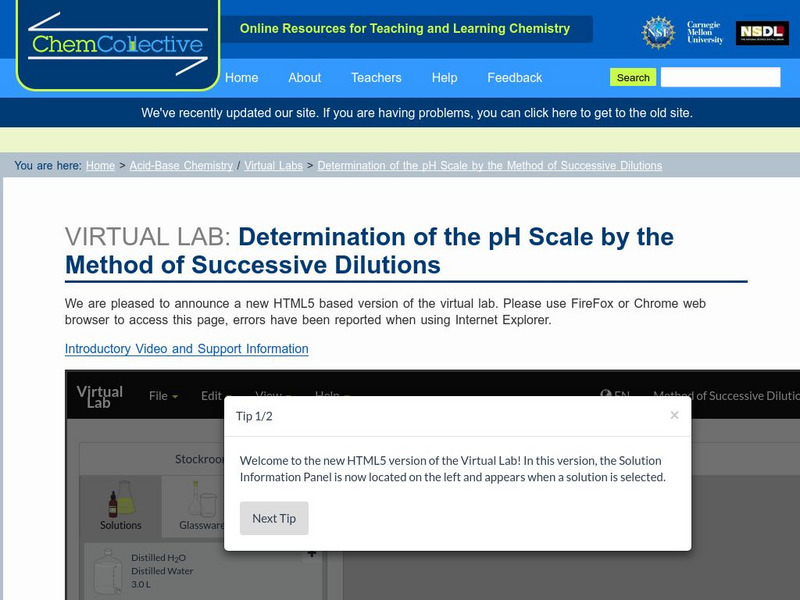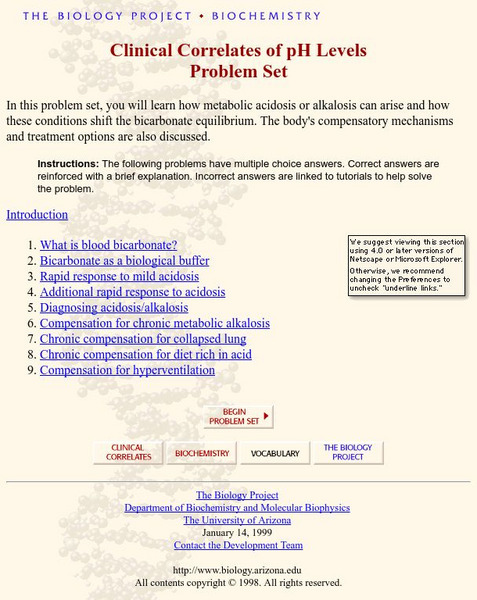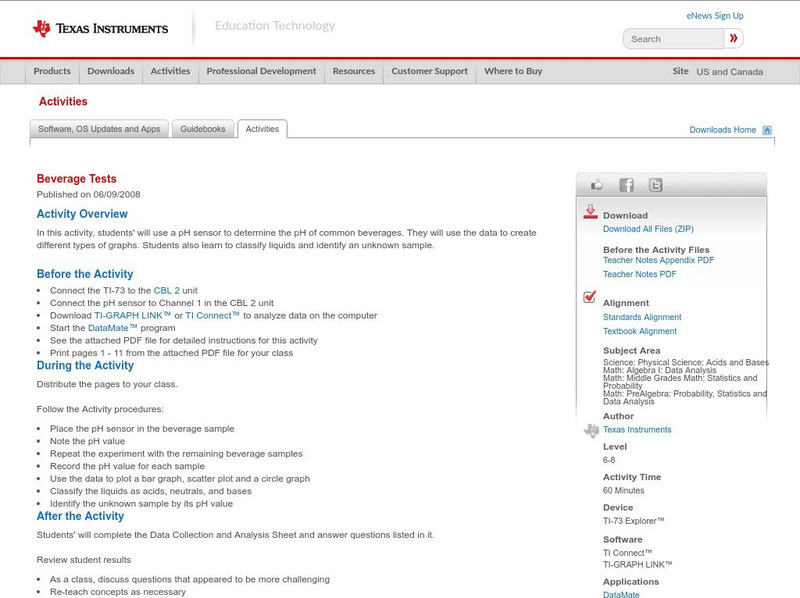Chemistry Collective
Chem Collective: Unknown Weak Acid Problem
Perform an experiment to determine the pKa and concentration of an unknown acid.
Chemistry Collective
Chem Collective: P H and Buffers Defined
This tutorial presents a review of the definitions for pH and buffer solutions
Chemistry Collective
Chem Collective: P H in the Absence of a Buffer
This tutorial describes the effects of adding strong base or strong acid to water.
Chemistry Collective
Chem Collective: How Buffers Work
This tutorial describes how buffers protect against pH changes when strong acid or base is added.
Chemistry Collective
Chem Collective: Determination of the P H Scale
This virtual lab activity where students perform the method of successive dilutions using HCl, NaOH, a pH meter, and universal indicator solution to help understand the logarithmic nature of the pH scale.
Chemistry Collective
Chem Collective: Standardization of Na Oh With a Khp Solution: Acid Base Titration
Use the Virtual Laboratory to standardize an unknown NaOH solution (approximately 0.2M) to four significant figures via titration with 25.00 mL of a KHP standard solution.
Chemistry Collective
Chem Collective: Determining the P Ka and Concentration Ratio
Use the virtual lab to determine the pKa of a protein then create a buffer solution with a specific concentration ratio of the protein in its protonated/ unprotonated form.
Frostburg State University
General Chemistry Online: Faq: Acids and Bases
Click the basic questions regarding acids, bases, and pH to view the answers. There are sections on basic concepts, buffer solutions, pH calculation, equilibrium constants, indicators, neutralization reactions, and titrations.
Khan Academy
Khan Academy: Bronsted Lowry Acid Base Theory
Understand the definition of Bronsted-Lowry acids and bases, strong and weak acids and bases, and how to identify conjugate acid-base pairs.
Other
Water on the Web
Water on the Web (WOW) is an advanced site allowing students to actively participate in data analysis from real research sites. Lesson plans on a range of topics are provided. There is also a tutorial for using Excel to graph WOW data.
St. Charles Place Education Foundation
Reading Bear: Ph, Gh Quiz
This site is an interactive quiz to assess knowledge of words that incorporate "ph" or "gh" in them. The quiz is designed to follow the "Reading Bear: ph, gh" lesson.
St. Charles Place Education Foundation
Reading Bear: Ph, Gh Lesson
In this beginning reading module, the instructor models how to pronounce words that incorporate "ph"or "gh" in them. Students are prompted to interact with the video segments at various times. Students can choose to sound out words, see...
Chiral Publishing
Chiral Publishing: An Introduction to Chemistry: P H and Acidic and Basic Solutions: Audio Book
Discover where solutions fall on the pH scale using this detailed pH chart.
University of Arizona
University of Arizona: Clinical Correlates of P H Levels Problem Set
In this interactive module, you will learn how metabolic acidosis or alkalosis can arise and how these conditions shift the bicarbonate equilibrium. The body's compensatory mechanisms and treatment options are also discussed.
Texas Instruments
Texas Instruments: P H
Students use a pH sensor to measure the pH level of water in a stream or lake. They examine how air pollutants like sulphur dioxide, nitrogen oxides, and carbon dioxide cause acid rain, which affects the pH of water bodies and aquatic...
Texas Instruments
Texas Instruments: Beverage Tests
In this activity, students' will use a pH sensor to determine the pH of common beverages. They will use the data to create different types of graphs. Students also learn to classify liquids and identify an unknown sample.
Texas Instruments
Texas Instruments: Beverage Tests
In this activity, students determine the pH of liquid samples. They get familiar with the pH scale, create graphs comparing pH levels, and compare data displayed as a scatter plot, a boxplot, a histogram, and a bar graph.
Texas Instruments
Texas Instruments: Water Quality
In this activity, students' will use a pH sensor to check and compare the pH values of various water samples. They will understand the meaning and effect of pH and factors that affect pH.
Texas Instruments
Texas Instruments: Microscale Acid Base Titration
In this activity, students' will use a pH sensor to determine the change in pH during a titration of a known concentration of NaOH and unknown concentration of HCl. Students' will determine the concentration of unknown HCl.
Texas Instruments
Texas Instruments: What Does a Buffer Do?
Buffers are solutions that resist a change in pH. In this activity, students will add HCl dropwise to a measured amount of water, monitoring the pH. Students then repeat the process, using a simple buffer prepared by combining baking...
Texas Instruments
Texas Instruments: Investigating Acid Strength
This activity allows students a hands-on opportunity to discover why different acids with the same molar concentration have different pH and the opportunity to investigate the effects of acid dilution on pH.
Texas Instruments
Texas Instruments: Acid Rain
Students use the pH sensor to measure changes in the pH when CO2 dissolves in water. They also study the changes in the pH when sulphuric acid is added to water and identify water bodies most likely to be affected by acid rain.
Texas Instruments
Texas Instruments: Jason: When P H Changes, What Happens?
JASON Aquatic Field Study: Explore how the pH of an aquatic site determines if the water is acidic, basic, or neutral by performing an experiment at a local aquatic site to measure the pH level.
Texas Instruments
Texas Instruments: Probing an Aquatic Ecosystem
In this activity, students' use a pH sensor and Temperature Sensor to measure and compare the pH and temperature of three aquariums over a period of several weeks. They will compare and understand how plants and animals affect the water...

























